Royal Leicestershire Regiment
| 17th Regiment of Foot 17th (Leicestershire) Regiment of Foot Leicestershire Regiment Royal Leicestershire Regiment | |
|---|---|
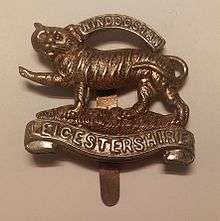 Badge of the Royal Leicestershire Regiment | |
| Active | 1688–1964 |
| Country |
|
| Branch |
|
| Type | Infantry |
| Role | Line infantry |
| Garrison/HQ | Glen Parva Barracks |
| Nickname(s) | The Tigers |
The Leicestershire Regiment (Royal Leicestershire Regiment after 1946) was a line infantry regiment of the British Army, with a history going back to 1688. The regiment saw service for three centuries, in numerous wars and conflicts such as both World War I and World War II, before being amalgamated, in September 1964, with the 1st East Anglian Regiment (Royal Norfolk and Suffolk), the 2nd East Anglian Regiment (Duchess of Gloucester's Own Royal Lincolnshire and Northamptonshire) and the 3rd East Anglian Regiment (16th/44th Foot) to form the present day Royal Anglian Regiment, of which B Company of the 2nd Battalion continues the lineage of the Royal Leicestershire Regiment.
History

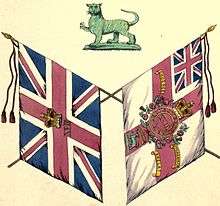
1688–1859
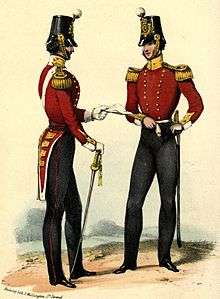
On 27 September 1688 a commission was issued to Colonel Solomon Richards to raise a regiment of foot. From 1688 to 1751 the regiment was known by the name of its various colonels. Following a failed attempt to break the Siege of Derry in 1689, Richards was dismissed and replaced by the Irishman George St George. The regiment saw service in the Flanders from 1694 to 1697, before moving to Ireland. In 1701 the regiment moved to the continent of Europe, and took part in the War of the Spanish Succession. In 1709 the unit returned to England, moving to Minorca in 1725.[1]
In 1751 a royal warrant assigned numbers to the regiments of the line, and the unit became the 17th Regiment of Foot. It saw service during the French and Indian War at Louisbourg in 1758, Ticonderoga in 1759, and in Caribbean engagements in 1761 and 1762.[1] Following that war it also saw duty during Pontiac's Rebellion before eventually returning to England in 1767.[1] The 17th were again in service during the American War of Independence, landing in Boston on New Year's Day 1776.[1] The regiment's performance at the Battle of Princeton in 1777 was commemorated in the addition of an unbroken laurel wreath to its insignia. Several companies were captured at the Battle of Stony Point by a daring night-time bayonet charge by "Mad" Anthony Wayne.[2] The regiment moved to Nova Scotia before returning to England in 1788.[1]
A royal warrant dated 31 August 1782 bestowed county titles on all regiments of foot that did not already have a special designation "to cultivate a connection with the County which might at all times be useful towards recruiting". The regiment became the 17th (Leicestershire) Regiment of Foot.[1]
The regiment was increased to two battalions in 1799 and both battalions served in the Netherlands before the second was disbanded in 1802. In 1804 the 17th moved to India, and remained there until 1823. In 1825 the regiment was granted the badge of a "royal tiger" to recall their long service in the sub-continent.[3] The Regiment was posted to New South Wales from 1830 to 1836.[4]
The regiment returned to India in 1837, and then took part in the Battle of Ghazni in July 1839 and the Battle of Khelat in November 1839 during the First Anglo-Afghan War.[1] The 17th next came under fire at the Siege of Sevastopol in Winter 1854 during the Crimean War.[1] In 1858 a second battalion was raised.[1]
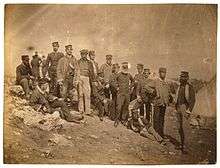
1859–1881
- See main article Leicester Town Rifles
An invasion scare in 1859 led to the emergence of the Volunteer movement, and within a year there were 10 Rifle Volunteer Corps in Leicestershire, with titles like the 'Leicester Town Rifles' and the 'Duke of Rutland's Belvoir Rifles'. Together these formed an administrative battalion, which became the 1st Volunteer Battalion of the Leicestershire Regiment in 1880. By 1900, when the unit provided a detachment of volunteers to serve alongside the Regulars during the Second Boer War, it operated as a double-battalion unit.[5][6][7][8][9]
1881–1914
The Childers Reforms of 1881 created multi-battalion regiments. Each regiment had a designated regimental district and also incorporated the local militia and rifle volunteers. Regiments of foot were no longer to have numbers, but were to bear a territorial title. The Leicestershire Regiment was accordingly formed on 1 July 1881.[10] The regimental depot was at Glen Parva Barracks, and the regiment consisted of:
- The 1st and 2nd Battalions (formerly the 1st and 2nd battalions of the 17th Foot)
- 3rd (Militia) Battalion (formerly the Leicestershire Militia)
- 1st Leicestershire Rifle Volunteer Corps, redesignated as the 1st Volunteer Battalion in 1883.[5][7]
The 1st and 3rd battalions fought in the Second Boer War 1899 – 1902, and the 1st Volunteer Battalion provided a detachment of volunteers to serve alongside the Regulars. The 2nd Battalion was stationed as a garrison regiment in Ireland from 1896, and in Egypt from February 1900.[9][11]
In 1908, with the creation of the Territorial Force, the 1st Volunteer Battalion formed the 4th and 5th Battalions (TF).[5][7][12] There was a minor controversy in the same year, when new colours were issued to the 1st Battalion to replace those of the 17th foot. A green tiger had been shown on the old colours and the regiment refused to take the new issue into use. The issue was resolved when the regiment received permission for the royal tiger emblazoned on the regimental colours to be coloured green with gold stripes.[13]
The First World War
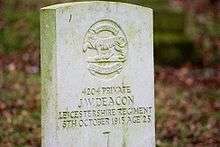
In the First World War, the regiment increased from five to nineteen battalions which served in France and Flanders, Mesopotamia and Palestine.[14]
Regular Army
The 1st Battalion landed at Saint-Nazaire as part of the 16th Infantry Brigade in the 6th Division in September 1914 for service on the Western Front.[14] The Battalion saw action at the Battle of Hooge in July 1915 capturing a number of enemy trenches.[15] It then suffered terrible losses at the Battle of the Somme in July 1916.[15]
The 2nd Battalion landed at Marseille as part of the Garhwal Brigade in the 7th (Meerut) Division in September 1914 also for service on the Western Front.[14] The Battalion saw action at the Battle of Neuve Chapelle in March 1915[15] when Private William Buckingham was awarded the Victoria Cross.[16] It then moved to Basra in Mesopotamia in December 1915[14] and took part in the action of Shaikh Saad in January 1916, the siege of Kut in Spring 1916, the capture of Sannaiyat in February 1917 and the fall of Baghdad in March 1917.[15] The battalion moved to Suez in January 1918 for service in the Palestine Campaign.[14]
Territorial Force
The 1/4th Battalion and 1/5th Battalion landed at Le Havre as part of the Lincoln and Leicester Brigade in the North Midland Division in March 1915 and February 1915 respectively for service on the Western Front.[14] The battalions saw action at the action of the Hohenzollern Redoubt in October 1915.[15] Lieutenant John Barrett was awarded the Victoria Cross for his actions while serving with the 1/5th Battalion at Pontruet in September 1918 in the closing stages of the war.[17]
The 2/4th Battalion and 2/5th Battalion landed in France as part of the 2nd Lincoln and Leicester Brigade in the 2nd North Midland Division in February 1917 also for service on the Western Front.[14]
New Army Battalions
The 6th (Service) Battalion, 7th (Service) Battalion, 8th (Service) Battalion and 9th (Service) Battalion landed in France as part of the 110th Brigade in the 37th Division in July 1915 for service on the Western Front.[14] The battalions took part in the attacks on High Wood at the Battle of the Somme in July 1916.[18] Lieutenant Colonel Philip Bent was posthumously awarded the Victoria Cross for his actions while in command of the 9th (Service) Battalion at the Battle of Polygon Wood in September 1917.[19]
The 11th (Service) Battalion (Midland Pioneers) landed in France as the pioneer battalion for the 6th Division in March 1916 also for service on the Western Front.[14] Meanwhile, the 14th (Service) Battalion landed in France as part of the 47th Brigade in the 16th Division in July 1918 also for service on the Western Front.[14]
Inter-War
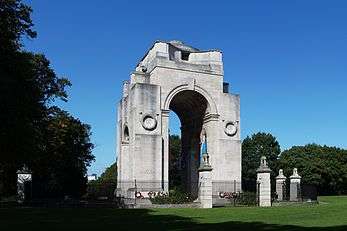
The regiment reverted to its pre-war establishment in 1919. The 1st Battalion was involved in the Irish War of Independence from 1920 to 1922, before moving to various overseas garrisons including Cyprus, Egypt and India. The 2nd Battalion was in India, Sudan, Germany and Palestine.[20]
In 1931 the regimental facing colour was changed from white to pearl grey. Previous to 1881 the 17th foot had "greyish white" facings.[13]
The 3rd (Militia) Battalion was placed in "suspended animation" in 1921, eventually being formally disbanded in 1953. In 1936 the 4th Battalion was converted into a searchlight nuts as 44th (The Leicestershire Regiment) Anti-Aircraft Battalion of the Royal Engineers.[7] The size of the Territorial Army was doubled in 1939, and consequently the 1/5th and 2/5th Battalions were formed from the existing 5th.[18]
The Second World War
The 1st Battalion was a Regular Army unit stationed in the Far East on the outbreak of the Second World War. The battalion fought the Imperial Japanese Army in the Malayan Campaign in early 1942 and sustained heavy casualties, temporarily amalgamating with the 2nd Battalion, East Surrey Regiment to create the British Battalion which was, however, later captured and the men of both battalions remained as prisoners of war (POWs) for the rest of the war.[21]
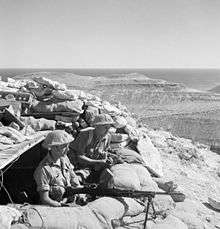
The 2nd Battalion, as part of the 16th Infantry Brigade, saw action at the Battle of Sidi Barrani in December 1940 and at the Battle of Bardia in January 1941 during the Western Desert Campaign.[18] The battalion then moved to Greece and took part in the Battle of Crete in May 1941 before transferring back to North Africa for the Battle of Tobruk in June 1941.[18] It then went to Ceylon in February 1942 and to India in January 1943: it became part of the Chindits and then saw action in the Burma Campaign.[18]
The Territorial infantry battalions, the 1/5th and 2/5th, both served in the war, the 1/5th with 148th Independent Infantry Brigade as part of 49th (West Riding) Infantry Division, the 2/5th with 138th Infantry Brigade, 46th Infantry Division, throughout the war. The 1/5th Battalion fought briefly in the disastrous Norwegian Campaign before being withdrawn to the United Kingdom and then to Northern Ireland.[22]
The 44th AA Battalion transferred to the Royal Artillery in 1940, becoming 44th (The Leicestershire Regiment) Searchlight Regiment, in which role it served through the Battle of Britain and the Blitz. In 1942 it changed role again, becoming 121st Light Anti-Aircraft Regiment, Royal Artillery, which served in North West Europe from Operation Overlord to Germany.[7][23][24][25]
Post-War
In 1946 the regiment was granted "royal" status, becoming the Royal Leicestershire Regiment.[26] In 1948, in common with all other infantry regiments, the 2nd Battalion was abolished. The 5th Battalion (TA) had been reformed in 1947.[12] In 1948 the regiment became part of the Forester Brigade, sharing a depot at Budbrooke Barracks in Warwickshire with the Royal Warwickshire Regiment, the Royal Lincolnshire Regiment and the Sherwood Foresters (Nottinghamshire and Derbyshire Regiment). Glen Parva was downgraded to regimental headquarters.[27]
The 1st Battalion served in the Korean War from 1951 to 1952. They subsequently moved to England (exercising the freedom of the City of Leicester in 1952), Germany, Sudan, where they operated with the Sudan Defence Force and departed on 16 August 1955,[28] Cyprus, Brunei and Aden.[29]
The Territorial units were reformed in 1947 as 579 (The Royal Leicestershire Regiment) Light Anti-Aircraft Regiment, RA and 5th Battalion Royal Leicesters. In 1961 they merged to become the 4th/5th Battalion.[7][12][23][25][30]
In 1963 the Forester Brigade was dissolved, with the Royal Leicesters and Royal Lincolns moving to the East Anglian Brigade where they joined the 1st, 2nd and 3rd East Anglian Regiments.[31]
Amalgamation into the Royal Anglian Regiment
On 1 September 1964 the regiments of the East Anglian Brigade became The Royal Anglian Regiment.[32] The 1st Battalion, Royal Leicestershire Regiment became the 4th (Leicestershire) Battalion, The Royal Anglian Regiment. The "Leicestershire" subtitle was removed on 1 July 1968 and the battalion was disbanded in 1975. The Royal Leicestershire heritage was included in the new regiment's button design, which features the royal tiger within an unbroken wreath.[33]
When the Territorial Army was converted into the Territorial and Army Volunteer Reserve (TAVR) in 1967, 4/5th Battalion provided two elements:[34]
- 4th (Leicestershire) Company, 5th (Volunteer) Battalion, Royal Anglian Regiment in TAVR II (units with a NATO role)
- The Royal Leicestershire Regiment (Territorials) in TAVR III (home defence units). The TAVR regiment was later reduced to B (Royal Leicestershire) Company, 7th (Volunteer) Battalion in the Royal Anglians. In 1978, 4th Coy 5th Bn and B Coy 7th Bn were amalgamated to form HQ (The Royal Leicestershire) Company of 7th Bn Royal Anglians [12]
A further reduction in the TA in 1999 saw HQ Company merged with C (Northamptonshire Regiment) Company to form C (Leicestershire and Northamptonshire) Company of the East of England Regiment, which was redesignated 3rd Bn Royal Anglian regiment in 2006.[35] Under the 2020 plans for the Army Reserve, C Company at Leicester will absorb B (Lincolnshire) Company by the end of 2016.[36]
Battle honours
The regiment was awarded the following battle honours:[37][38]
- Earlier Wars
- Namur, 1695, Louisburg, Martinique, 1762, Havannah, Ghuznee, 1839, Khelat, Afghanistan 1839, Sevastopol, Ali Masjid, Afghanistan 1878–79, Defence of Ladysmith, South Africa, 1899–1902
- First World War (Ten selected honours, shown in bold type, were borne on the colours.)
- Aisne, 1914, '18, La Bassee, 1914, Armentieres, 1914, Festubert 1914, '15, Neuve Chapelle, Aubers, Hooge, 1915, Somme, 1916, '18, Bazentin, Flers-Courcelette, Morval, Le Transloy, Ypres, 1917, Polygon Wood, Cambrai, 1917, '18, St Quentin, Lys, Bailleul, Kemmel, Scherpenberg, Albert, 1918, Bapaume, 1918, Hindenburg Line, Épehy, St Quentin Canal, Beaurevoir, Selle, Sambre, France and Flanders, 1914–18, Megiddo, Sharon, Damascus, Palestine, 1918, Tigris, 1916, Kut-el-Amara, 1917, Baghdad, Mesopotamia, 1915–18
- Second World War (Ten selected honours, shown in bold type, were borne on the colours.)
- Norway, 1940, Antwerp-Turnhout Canal, Scheldt, Zetten, North-West Europe, 1944–45, Jebel Mazar, Syria, 1941, Sidi Barrani, Tobruk, 1941, Montaigne Farm, North Africa, 1940–41, '43, Salerno, Calabritto, Gothic Line, Monte Gridolfo, Monte Colombo, Italy, 1943–45, Crete, Heraklion, Kampar, Malaya, 1941–42, Chindits, 1944
- Korean War:
- Maryang-San, Korea, 1951–52
Colonels
The colonels of the regiment were as follows:
- 1688-1689: Col Solomon Richards [39]
- 1689-1695: George St George [39]
- 1695: Col James Courthorpe [39]
- 1695: Lt-Col Sir Matthew Bridges [39]
- 1703-1707: Lt-Col Holcroft Blood [39]
- 1707-1722: Lt-Col James Wightman [39]
- 1722: Brig-Gen Thomas Ferrers [39]
- 1722-1742: Col James Tyrrell [39]
- 1742-1752: Col John Wynyard [39]
The 17th Regiment of Foot
- 1752-1757: Brig-Gen Edward Richbell [39]
- 1757-1759: Col John Forbes [39]
- 1759-1782: Brig-Gen Hon. Robert Monckton [39]
The 17th (Leicestershire) Regiment
- 1782-1792: Major-Gen George Morrison [39]
- 1792-1819: Major-Gen George Garth [39]
- 1819-1840: Lt-Gen Sir Josiah Champagné GCH [39]
- 1840-1842: Gen Sir Frederick Augustus Wetherall GCH [39]
- 1843–1854: Lt-Gen Sir Peregrine Maitland KCB [39]
- 1854–1860: Lt-Gen. Thomas James Wemyss, CB [40]
- 1860–1868: Gen. Sir Richard Airey, 1st Baron Airey, GCB [40]
- 1868–1871: Lt-Gen. John Grattan, CB [40]
- 1871–1879: Gen. William Raikes Faber, CB [40]
- 1879–1890: Gen. Richard Curzon-Howe, 3rd Earl Howe, GCVO, CB [40]
The Leicestershire Regiment
- 1890–1895: Lt-Gen. John Christopher Guise, VC, CB [40]
- 1895–1903: Gen. Sir John Ross, GCB[40]
- 1903–1905: Maj-Gen. George Tito Brice[40] [40]
- 1905–1912: Maj-Gen. Archibald Hammond Utterson, CB [40]
- 1912–1916: Maj-Gen. William Dalrymple Tompson, CB [40]
- 1916–1953: Maj-Gen. Sir Edward Mabbott Woodward, KCMG, CB [40]
- 1943–1948: Gen. Sir Clive Gerard Liddell, KCB, CMG, CBE, DSO [40]
The Royal Leicestershire Regiment
- 1948–1954: Brig. Harold Senhouse Pinder, CBE, MC [40]
- 1954–1963: Lt-Gen. Sir Colin Bishop Callander, KCB, KBE, MC [40]
- 1963–1964: Maj-Gen. Douglas Anthony Kendrew, CB, CBE, DSO
Victoria Crosses
The following members of the Regiment were awarded the Victoria Cross:
- Lieutenant John Cridlan Barrett, First World War (24 September 1918)
- Lieutenant Colonel Philip Eric Bent, Belgium, First World War (1 October 1917)
- Private William Buckingham, First World War (10/12 March 1915)
- Corporal Philip Smith, Radan, Crimean War (18 June 1855)
See also
- John Sheppard First soldier to destroy enemy tank
Notes
- 1 2 3 4 5 6 7 8 9 "Part I Origin until 1914". Royal Leicestershire Regiment. Retrieved 10 January 2016.
- ↑ "Stoney Point Battlefield". Revolutionary Day. Retrieved 10 January 2016.
- ↑ 24 June 1825: His Majesty has been pleased to approve of the 17th or Leicestershire Regiment of foot bearing on its colours and appointments the figure of the "Royal Tiger," with the word "Hindoostan" superscribed, as a lasting testimony of the exemplary conduct of the Corps during its period of service in India, in the year 1804 to 1823. The London Gazette: no. 18149. p. 1105. 25 June 1825.
- ↑ "Australia's Red Coat Regiments". Retrieved 10 January 2016.
- 1 2 3 Westlake, pp. 154–6.
- ↑ Beckett, Appendix VII.
- 1 2 3 4 5 6 "4th Battalion, The Royal Leicestershire Regiment [UK]". Archived from the original on 15 July 2007. Retrieved 10 January 2016.
- ↑ MacDonald, p. 11.
- 1 2 Leslie.
- ↑ The London Gazette: no. 24992. pp. 3300–3301. 1 July 1881.
- ↑ "Naval & Military intelligence". The Times (36058). London. 6 February 1900. p. 10.
- 1 2 3 4 "5th Battalion, The Royal Leicestershire Regiment [UK]". Archived from the original on 10 September 2006. Retrieved 10 January 2016.
- 1 2 Military History Society Bulletin, Special Issue No.1, 1968
- 1 2 3 4 5 6 7 8 9 10 Baker, Chris. "The Leicestershire Regiment". The Long, Long Trail. Retrieved 21 March 2014.
- 1 2 3 4 5 "Part II The First World War". Royal Leicestershire Regiment. Retrieved 11 January 2015.
- ↑ The London Gazette: (Supplement) no. 29146. p. 4143. 28 April 1915. Retrieved 29 April 2015.
- ↑ The London Gazette: (Supplement) no. 31067. pp. 14774–14775. 13 December 1918. Retrieved 7 April 2015.
- 1 2 3 4 5 "Part IV The Second World War". Royal Leicestershire Regiment. Retrieved 10 January 2016.
- ↑ The London Gazette: (Supplement) no. 30471. pp. 722–723. 8 January 1918. Retrieved 7 April 2015.
- ↑ "Part III Between the Wars". Royal Leicestershire Regiment. Retrieved 10 January 2015.
- ↑ "British Battalion prisoner of war information". Children and Families of Far East Prisoners of War. Retrieved 10 January 2015.
- ↑ Joslen, pp. 325–6, 333.
- 1 2 Litchfield, pp. 139–40.
- ↑ Routledge, pp 314, 319, 350, 360–5.
- 1 2 Farndale, Annex M, pp. 338–9.
- ↑ Army Order 167/1946
- ↑ Whitaker's Almanack 1956, p. 471
- ↑ Palmer, Robert. "British Troops in the Sudan: History & Personnel" (PDF). www.britishmilitaryhistory.co.uk. Retrieved 21 March 2014.
- ↑ "Looking Back - Graham Eustace - Aden and Radfan". Retrieved 10 January 2016.
- ↑ "British Army units from 1945 on". Retrieved 10 January 2016.
- ↑ Goldschmidt, Michael (2009). "Marching with the Tigers: The History of the Royal Leicestershire Regiment 1955-1975". Pen & Sword. ISBN 978-1848840355.
- ↑ Swinson, p.270
- ↑ "Symbols and Badges". Royal Anglian Regiment Museum. Retrieved 21 March 2014.
- ↑ "5th Battalion, The Royal Leicestershire Regiment [UK]". Archived from the original on 16 August 2007. Retrieved 10 January 2016.
- ↑ "The East of England Regiment [UK]". Archived from the original on 7 July 2007. Retrieved 10 January 2016.
- ↑ Army 2020 Reserve Structure and Basing Changes at British Army site.
- ↑ "Battle Honours". The Royal Leicestershire Regiment. Royal Tigers' Association. Retrieved 11 March 2013.
- ↑ Swinson, Arthur (1972). A Register of the Regiments and Corps of the British Army. London: The Archive Press. pp. 105–106. ISBN 0-85591-000-3.
- 1 2 3 4 5 6 7 8 9 10 11 12 13 14 15 16 17 Cannon, Richard. Historical record of the Seventeenth, or the Leicestershire Regiment of Foot: containing an account of the formation of the regiment in 1688, and of its subsequent services to 1848.
- 1 2 3 4 5 6 7 8 9 10 11 12 13 14 15 "The Leicestershire Regiment". regiments.org. Retrieved 9 July 2016.
References
- Beckett, Ian F.W. (1982). Riflemen Form: A study of the Rifle Volunteer Movement 1859–1908. Aldershot: Ogilby Trusts. ISBN 0 85936 271 X.
- Farndale, Gen Sir Martin (1996). History of the Royal Regiment of Artillery: The Years of Defeat: Europe and North Africa, 1939–1941. Brasseys. ISBN 1-85753-080-2.
- Joslen, Lt-Col H.F. (2003). Orders of Battle, United Kingdom and Colonial Formations and Units in the Second World War, 1939–1945. Uckfield: Naval & Military Press. ISBN 1-843424-74-6.
- Leslie, N.B. (1970). Battle Honours of the British and Indian Armies 1695–1914. London: Leo Cooper. ISBN 0-85052-004-5.
- MacDonald, Alan (2008). A Lack of Offensive Spirit? The 46th (North Midland) Division at Gommecourt, 1st July 1916. West Wickham: Iona Books. ISBN 978-0-9558119-0-6.
- Routledge, Brig N.W. (1994). History of the Royal Regiment of Artillery: Anti-Aircraft Artillery 1914–55. Brassey's. ISBN 1-85753-099-3.
- Spurling, J.M.K. (1969). The Tigers – a short history of the Royal Leicestershire Regiment. Leicester.
- Swinson, Arthur (1972). A Register of the Regiments and Corps of the British Army. London: The Archive Press. ISBN 0-85591-000-3.
- Westlake, Ray (2010). Tracing the Rifle Volunteers. Barnsley: Pen and Sword. ISBN 978 1-84884-211-3.
External links
| Wikimedia Commons has media related to Royal Leicestershire Regiment. |
- "The Royal Leicestershire Regiment". Royal Tigers' Association. Retrieved 11 March 2013.
- Land Forces of Britain, the Empire and Commonwealth (Regiments.org)
- British Army units from 1945 on.
- Army 2020 Reserve Structure and Basing Changes at British Army site
| Preceded by 17th Regiment of Foot |
The Leicestershire/Royal Leicestershire Regiment 1881–1964 |
Succeeded by Royal Anglian Regiment |
